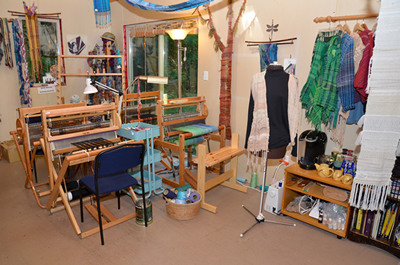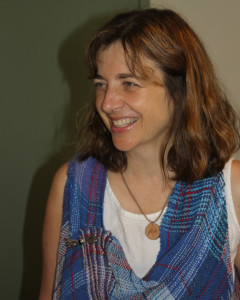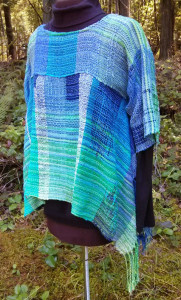Imagine a world where you can play with colour and texture, where you can follow your intuition, and experiment to create unique items of clothing or works of art that express your individuality; imagine a world where there are no mistakes. This is the world of Saori Weaving, a world Terri Bibby inhabits and shares from her studio on Salt Spring Island.
Nestled into the trees on a hill at the north end of Salt Spring Island, Terri’s studio is a treasure trove in the woods. Cones of cotton, wool and silk fibre, in every imaginable colour and shade line one wall, along with boxes of local spun and dyed wool and silk strips that have been recycled from saris of all hues. Woven clothing hangs on racks along another wall, and a few coloured cloth banners float from the ceiling. This profusion of colour, texture and pattern contrasts with the simplicity of the simple rectangular room, and the plain light wood, and elegance, of the half dozen small looms that fill the floor space. A simple worktable with a sewing machine and a couch cosy up the back of the room. Elves might work in such a place as this.
Indeed, the studio is often humming with quiet activity, and people from all walks of life, local and far-flung, make their way through the trees to the studio to see Terri for group workshops or one-on-one sessions, to share their weaving and ideas, and to pick up materials.
Terri, herself, is a quiet, slender woman with an unassuming manner and an attentive kindness. Typically dressed in jeans and her own beautiful woven creations, often in interesting blues and greens, she has a practical down to earth vibe about her. She sees herself less as teaching weaving as “holding a space for people to explore their creativity”. Weaving the Saori way, she says, is “to find beauty through lack of intention.”
In addition to offering individual and group workshops, Terri also hosts weaving retreats which may include taking in some of Salt Spring’s other attractions, and takes her looms on the road to participate in community events and to work with groups who want to learn the Saori way. (Terri and her photographer/filmmaker husband, Alan Bibby, also run a small B & B.)
Terri also encourages and communicates with other weavers through her prolific and colourful web presence. Here, her enthusiasm bursts forth as she uses her website, her blog, Facebook, and Instagram to promote her services, share her weaving adventures, and connect readers to each other and to Saori studios around the world. Check out, for example, her album of photos from her May Saori studio tour in Japan on her Facebook page. (This page is open to the public. Click on photos, then albums.)
Terri’s own journey to Saori began in a love of fibre arts fostered in childhood by her grandmother in Edmonton. As a young teenager, she was an avid knitter and crocheter, and she discovered weaving when she took classes at a local community arts centre. She joined the weavers’ guild in her early twenties, and studied fibre arts at Olds College and Grant McEwen College in Alberta. Years later, when she was working as an information technology consultant and weaving on a big Swedish loom, she found Saori.
It was at the Cowichan Fleece and Fibre Festival in 2005. A woman named Kim Cowley-Adam was weaving on a Saori loom, and Terri was immediately drawn to the spontaneity and freedom of the process. In that moment, she knew that she wanted to learn about Saori and that she wanted to share it with others. Kim, who had the sole proprietorship of Saori in Canada, was encouraging. She sold Terri a loom and before long, her proprietorship as well. Many Saori workshops and conferences, three trips to Japan and a wealth of Saori experience later, Terri is still learning about, and through, Saori.
Why Saori, though, and how is it different from traditional weaving? The most immediately obvious difference is the way you learn to weave. Terri explains that traditionally you might take a series of lessons, in which you learn the basics of how to set up the loom and how to create different weaves and effects. You practise these techniques, creating samples that demonstrate the skills you have developed. Before beginning a project, everything is planned in detail and you know exactly what you want the weaving to look like.
In contrast to this methodical approach in which most of the creativity is in the planning stage, with Saori the whole process is creative. When you first visit Terri’s studio, the loom is already set up, and you can just start weaving. You follow your intuition to select the colours and fibres to use, and you learn by experimenting. The weaving emerges from this process, and sometimes it is only then that you can see what the cloth is meant to be. Likewise, Saori clothing is typically made from simple patterns based on Japanese clothes-making practices that involve folding fabric in a shape-making process similar to origami. The whole Saori process is thus accessible to the beginning weaver. Weavings can be as simple or as sophisticated as the weaver desires, and each piece of weaving, each item of clothing, is a unique expression of that individual.
To Terri, however, Saori is more than just an approach to weaving; it is a series of beliefs about the creative process, and ultimately a philosophy of life. This philosophy was articulated by a Japanese woman, Misao Jo, who started the Saori movement 44 years ago, and it all began with an epiphany she experienced as a young woman.
As a young woman, Misao Jo studied Ikebana, traditional Japanese flower arranging. In the traditional teaching, students learn by studying and copying the arrangements of their teachers. One day, in contemplating a flower that she was using for an arrangement, Misao Jo had a profound realization that was to change her view of the art of creating. As she considered the beauty of the flower, she was struck with a deep awareness that just as each flower is unique, so too is each person. She became convinced that the purpose of art and the creative process is for the person to discover and express his or her true, and unique, self. Later, as an Ikebana teacher, she encouraged her students to follow their inner feelings when arranging, instead of having them learn by copying her arrangements, as was customary.
Then, at age 57, Misao Jo decided she wanted to fulfill her long-held desire to express herself through weaving, and was inspired to create a simple loom. With her sons’ help, they fashioned the Saori loom, a design one of her sons continues to refine: simple, portable, aesthetically pleasing and easy to use.
Misao Jo had never woven before, and she simply began to weave freestyle. She discovered that what traditional weavers might consider “flaws” were not flaws to her. She considered them, rather, as individual variations that expressed the creative spirit of the weaver, and that added to the beauty of the piece. People liked her unique creations and soon they began to ask her to show them how to weave in this way. Today, an estimated 40,000 people practise Saori in Japan, and there are studios in many other countries. At 101, Misao Jo continues to be the mother of this movement.
The longer Terri is involved in Saori, the more deeply she understands and appreciates the Saori philosophy of creation. Misao Jo articulates four main slogans that encapsulate the main teachings of the Saori way. One of these slogans encourages Saori weavers to “see the world with eyes that shine”. To Terri, this means that we can be open to seeing beauty in all kinds of things, and within each person. Saori weaving allows for the expression of this beauty. Terri enjoys sharing Saori with those who did not realize they could create something beautiful and unique. From her studio in the woods, and from eyes that shine, she shares her journey of self-discovery and helps to launch others on their own journeys.
Check out Terri’s website and blog here.
 Deborah Graham
Deborah Graham
Email Deborah
See all articles by Guest Author







Thank you for this wonderful article. It really gets to the essence of SAORI weaving and the beauty of Terri Bibby.
Thank-you, Karen. I’m really glad you like the article.